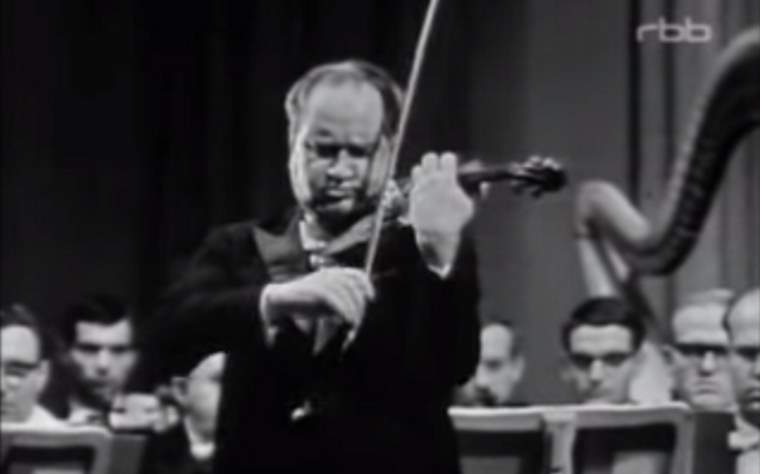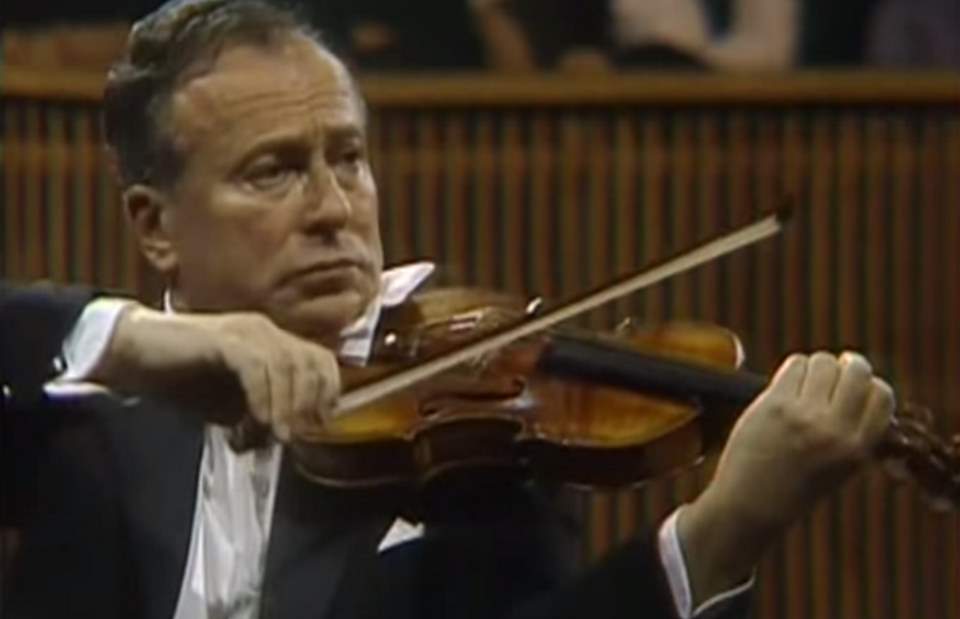Accompanied by the hr-Sinfonieorchester (Frankfurt Radio Symphony Orchestra), Hilary Hahn performs Pyotr Ilyich Tchaikovsky’s Violin Concerto in D major, Op. 35. Conductor: Andrés Orozco-Estrada. Recorded on September 7, 2023, at the hr-Sendesaal Frankfurt.
Tchaikovsky’s Violin Concerto
Tchaikovsky’s Violin Concerto in D major, Op. 35, is one of the most celebrated pieces in the violin repertoire and a landmark in the history of classical music. Composed in 1878, this concerto was written during a tumultuous period in Tchaikovsky’s life, shortly after the end of his brief and unhappy marriage. He composed the concerto while staying in Clarens, Switzerland, and the music seems to reflect both his personal struggles and the tranquility of his surroundings.
When Tchaikovsky first presented the concerto to Leopold Auer, a prominent violinist of the time for whom the piece was originally intended, Auer declared it unplayable. This initial rejection was a major disappointment for Tchaikovsky, but it didn’t spell the end for the concerto. It was later premiered by Adolf Brodsky in 1881 in Vienna, though the reception was mixed. The influential critic Eduard Hanslick famously panned the work, but this negative reception did not last. Over time, the concerto gained acceptance and became recognized for its brilliance, emotional depth, and technical demands.
Technically, the concerto is a showcase for the capabilities of the violin, pushing the boundaries of what the instrument can achieve. It demands remarkable virtuosity from the soloist, requiring rapid finger work, a wide range of bowing techniques, and an ability to handle complex rhythms and textures. At the same time, it’s not just a technical showpiece; it’s deeply emotional, capturing a wide range of sentiments from melancholy to exuberance.
Today, Tchaikovsky’s Violin Concerto is considered a masterwork and a staple of the violin repertoire, performed and recorded by many of the world’s leading violinists. Its lasting legacy stands as a testament to Tchaikovsky’s genius and his ability to convey profound emotions through his compositions, as well as his knack for creating melodies that resonate with listeners long after the music has ended.
Movements
There are three movements. With start times in the video:
- Allegro moderato 00:00
- Canzonetta. Andante 20:40
- Finale. Allegro vivacissimo 27:46
1. Allegro moderato
The first movement of Tchaikovsky’s Violin Concerto in D Major, Op. 35, is marked “Allegro moderato,” and it stands as a magnificent opening that sets the stage for the entire concerto. The movement is constructed in a sonata-allegro form, a common structure for first movements in concertos, which involves exposition, development, and recapitulation sections.
The orchestra introduces the main thematic material before the violin soloist enters. When the violin does join in, it does so with a sense of both grandeur and intimacy. The lyrical first theme is introduced by the violin and is notable for its emotional depth and melodious character. It’s followed by a more lively and rhythmically complex second theme, which provides a contrast and adds a layer of complexity to the movement. The interplay between the soloist and the orchestra is one of the highlights here, as Tchaikovsky brilliantly crafts a dialogue that showcases not only the technical prowess of the violinist but also the emotive possibilities of the instrument.
The development section is where the soloist gets to display their virtuosity. Here, Tchaikovsky subjects the main themes to various transformations and elaborations. The section is filled with intricate passages, including rapid scales, arpeggios, and double stops, demanding impeccable technique and emotional investment from the performer.
The recapitulation brings back the main themes, this time enriched by the journey the music and the listener have undergone. The movement concludes in a rousing manner, leaving an indelible impact and setting the stage for the subsequent movements.
Tchaikovsky’s use of melody, orchestration, and emotional contrast in this movement makes it a favorite among both performers and audiences. The composer’s innate ability to capture a broad emotional spectrum while adhering to classical forms is fully on display here. It’s a movement that challenges the performer technically while offering them ample opportunities to showcase their interpretive skills.
The first movement is not just an opening act but a compelling musical narrative in its own right, setting the emotional and technical tone for the concerto as a whole.
2. Canzonetta. Andante
The second movement of Tchaikovsky’s Violin Concerto in D Major, Op. 35, is marked “Canzonetta: Andante,” and it serves as an emotive interlude between the vigorous first and third movements. It is relatively shorter than the other movements but holds a special place for its lyrical beauty and emotional resonance.
The word “Canzonetta” suggests a little song, and indeed, the movement is song-like in its simplicity and expressiveness. It opens with a brief, somewhat melancholic introduction by the orchestra, setting a subdued and introspective mood. This prepares the listener for the entry of the violin, which introduces the main theme, a heartfelt melody that seems to sing directly to the listener’s soul.
The movement is notably restrained in its orchestration, featuring primarily strings and woodwinds. The absence of brass and percussion lends the movement a sense of intimacy, as if Tchaikovsky intentionally scaled back the ensemble to create a more personal, inward-looking space. This creates a stark contrast with the first movement’s exuberance and the technical fireworks that are to come in the finale.
One of the remarkable qualities of this movement is its brevity. Tchaikovsky doesn’t overstay his welcome; instead, he presents a concise yet profoundly emotional musical idea that serves as a respite before the storm of the third movement. The violin’s dialogue with the orchestra is subtle but deeply touching, reflecting perhaps a moment of introspection or even nostalgia. While it’s short, the second movement has a completeness to it, almost like a brief but meaningful chapter in a larger narrative.
Though it may lack the overt virtuosity of the other movements, the second movement’s beauty lies in its emotional depth and the purity of its melodic lines. It’s a testament to Tchaikovsky’s ability to convey profound feelings through relatively simple musical means. Violinists often find this movement challenging not because of technical difficulties, but because of the emotional maturity and sensitivity required to bring the music to life.
The second movement ends quietly, almost reluctantly, as if preparing the listener for the rousing finale that follows. But its emotional impact lingers, providing a contrasting soulful core to the overall concerto.
3. Finale. Allegro vivacissimo
The finale of Tchaikovsky’s Violin Concerto in D Major, Op. 35, is marked “Finale: Allegro vivacissimo,” and as the tempo marking suggests, it is a lively and fast-paced conclusion to the concerto. This movement serves as a counterbalance to the reflective mood of the second movement, bringing the listener back to a state of excitement and exhilaration.
Musically, the third movement is rooted in Russian folk idioms, which can be heard in the rhythmic patterns, dance-like motifs, and energetic themes that populate the movement. The music seems to burst forth right from the start, wasting no time in setting a jubilant tone. One of the most distinctive elements of this finale is its use of a rondo-like form, which involves the repetition of a primary theme interspersed with contrasting episodes. This structure allows for a captivating interplay between the solo violin and the orchestra, creating a vibrant and dynamic musical landscape.
The solo violin part is incredibly demanding, filled with rapid passages, challenging string crossings, and numerous double stops. Yet, despite the technical hurdles, the music never feels weighed down. Instead, it has a sense of freedom and spontaneity, as if the soloist is riding a wave of musical enthusiasm. The orchestra is not just an accompaniment but a full partner in this musical adventure, adding depth and contrast to the violin’s acrobatics.
The energy remains high throughout the movement, building to a thrilling climax that leaves both the performers and the audience breathless. The concerto ends on a triumphant note, tying together the emotional and technical threads introduced in the previous movements and concluding the musical journey in a spectacular fashion.
In a way, the third movement encapsulates the spirit of the entire concerto: it’s bold, passionate, and unapologetically virtuosic. It’s a fitting end to a work that showcases the full range of the violin’s capabilities, from the soulful melodies of the second movement to the exuberant technical display of the finale.
Tchaikovsky’s genius shines in the way he melds technical prowess with emotional depth, wrapping up the concerto in a way that leaves a lasting impression. This finale not only challenges the violinist but also brings the audience to their feet, offering a thrilling end to one of the most beloved concertos in the violin repertoire.
Sources
- Violin Concerto (Tchaikovsky) on Wikipedia




